Asteroids
9-3 Most asteroids orbit the Sun between Mars and Jupiter
In 1802, less than two years after the asteroid (now also a dwarf planet) Ceres was discovered, the German astronomer Heinrich Olbers (1758–1840) observed another faint, starlike object that moved against the background stars. He called it Pallas, after the Greek goddess of wisdom. Like Ceres, Pallas orbits the Sun in a nearly circular path between the orbits of Mars and Jupiter. Pallas is even dimmer and smaller than Ceres and has a diameter of only 600 km (375 mi).
281
Only two more of these asteroids—Juno and Vesta—were found until the mid-1800s, when telescopes improved. Astronomers then began to discover many more asteroids orbiting the Sun at distances from 2 to 3½ AU, between the orbits of Mars and Jupiter. This region of the solar system is now called the asteroid belt (Figure 9-8). Asteroids whose orbits lie entirely within this region are called belt asteroids.
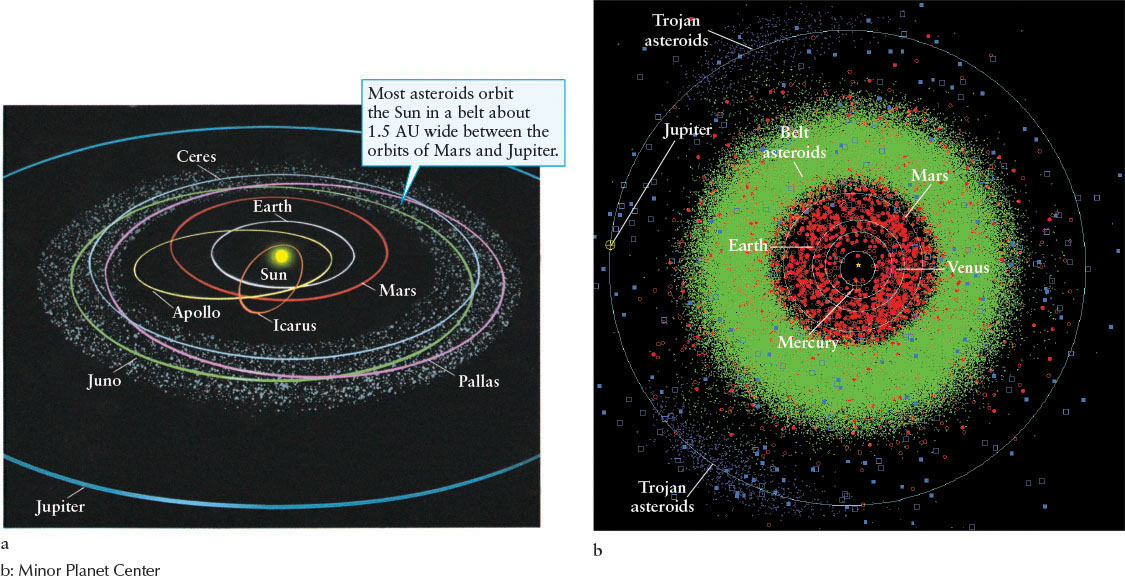
The spacecraft Dawn was sent in 2007 to explore the two most massive belt asteroids Ceres and Vesta, neither of which can be well resolved from Earth. Exquisitely detailed images of Vesta, taken in 2012, reveal that its heavily cratered northern hemisphere is more than a billion years older than the smoother southern hemisphere (Figure 9-9a). Nevertheless, a mountain 20 km (12.4 mi) high pokes up from Vesta’s south pole. This mountain is taller than Earth’s tallest mountain, Mauna Kea, in Hawaii. When measured from the ocean bottom, Mauna Kea is 4.2 km (2.6 mi) high. Analysis of the asteroid from the data provided by Dawn reveals that this asteroid differentiated, meaning that heavier elements, predominantly iron, settled to the core, while the lighter rock floated upward (Figure 9-9b). Dawn will arrive at Ceres in 2015.
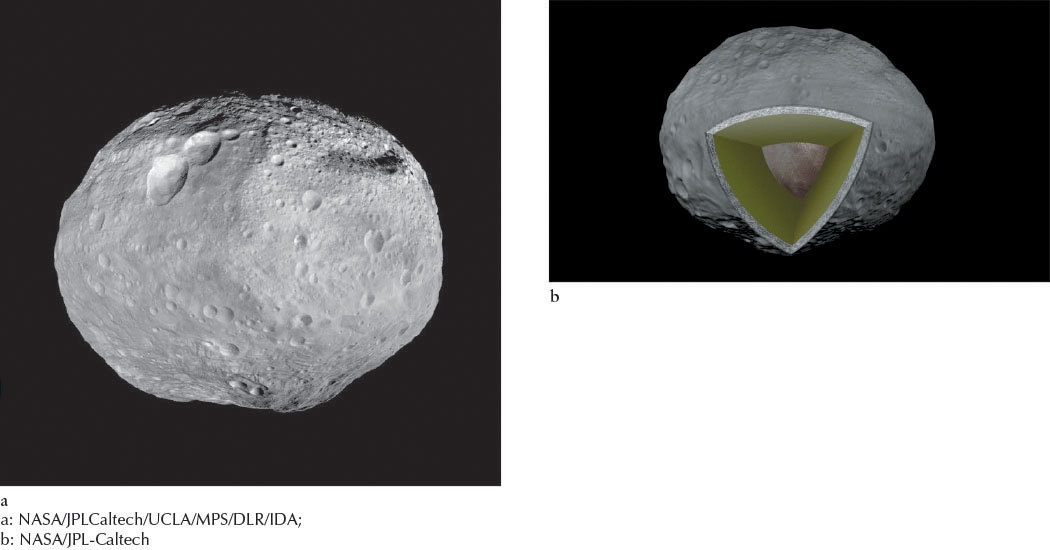
Confirming Observations
New findings in science must be confirmed or replicated by other scientists before discoveries or observations are accepted by the scientific community. Therefore, asteroid observations need to be repeated several times to determine exact orbits and eliminate the possibility that a sighting is of a known asteroid or other object.
Asteroids were discovered one by one throughout the nineteenth century. The next real breakthrough came in 1891, when the German astronomer Max Wolf (1863–1932) applied photographic techniques to asteroid searching. A total of 300 asteroids had been found up to that time, each painstakingly discovered by scrutinizing the skies for faint, uncharted “stars” whose positions shifted slowly from one night to the next. With the advent of astrophotography, however, the floodgates were opened. Astronomers could simply aim a camera-equipped telescope at the stars and take long exposures. If an asteroid happened to be in the field of view, it left a distinctive trail on the photographic plate (Figure 9-10). Using this technique, Wolf alone discovered 228 asteroids.
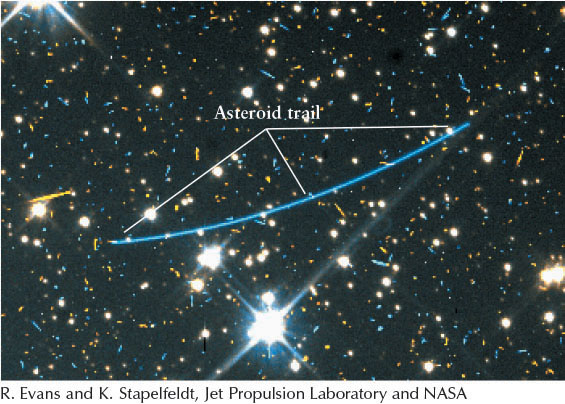
Margin Question 9-3
Question
Why do astronomers doubt that the asteroid belt was once made up of a single planet?
282
Records of all objects smaller than planets in our solar system are kept by the Minor Planet Center in Cambridge, Massachusetts. The center reports that as of mid-2013, the existence of 625,734 asteroids had been confirmed, with more than 100,740,200 other observations remaining to be processed. Based on these observations, we know that Ceres, the largest asteroid, alone accounts for about 30% of the mass of all known asteroids combined. Only three asteroids—Ceres, Vesta, and Pallas—have diameters greater than 300 km. Indeed, the number of asteroids increases dramatically with decreasing size: Only 41 asteroids have diameters between 200 and 300 km; 250 more are bigger than 100 km across; and there are thought to be tens of millions that are less than 1 km across.
 The Nice model of how the solar system formed explains that most of the debris in the present area of the asteroid belt was ejected by the passage of young Jupiter through this region going both inward and then out again, as discussed in Section 5-3. If all of the present asteroids were collected into a single body, it would have had a diameter of only 1500 km, or 12% of Earth’s diameter. This is less than two-thirds the diameter of Pluto and half the diameter of our Moon. Like Pluto, such a body would not have enough gravitational attraction to clear the space around it of other bodies. Therefore, a single body that contains the mass of all of the asteroids also would not qualify as a planet.
The Nice model of how the solar system formed explains that most of the debris in the present area of the asteroid belt was ejected by the passage of young Jupiter through this region going both inward and then out again, as discussed in Section 5-3. If all of the present asteroids were collected into a single body, it would have had a diameter of only 1500 km, or 12% of Earth’s diameter. This is less than two-thirds the diameter of Pluto and half the diameter of our Moon. Like Pluto, such a body would not have enough gravitational attraction to clear the space around it of other bodies. Therefore, a single body that contains the mass of all of the asteroids also would not qualify as a planet.
While Jupiter likely disrupted the mass developing in what is now the asteroid belt some 4.5 billion years ago, the fact that it has left this region does not mean that its influence there has ended.
283
9-4 Jupiter’s gravity creates gaps in the asteroid belt
In 1867, the American astronomer Daniel Kirkwood (1814–1895) called attention to gaps in the asteroid belt. These features, called Kirkwood gaps, show the influence of Jupiter’s gravitational attraction there today. Figure 9-11, a graph of asteroid orbital periods, has gaps at simple fractions ( ,
,  ,
,  , and
, and  ) of Jupiter’s orbital period. The gravitational pull of Jupiter created these empty regions by giving objects in them periodic reinforcing tugs that pulled the orbiting bodies to different orbits. The effect is analogous to the gravitational resonance of Mimas creating the Cassini division in Saturn’s rings (see Section 8-10).
) of Jupiter’s orbital period. The gravitational pull of Jupiter created these empty regions by giving objects in them periodic reinforcing tugs that pulled the orbiting bodies to different orbits. The effect is analogous to the gravitational resonance of Mimas creating the Cassini division in Saturn’s rings (see Section 8-10).
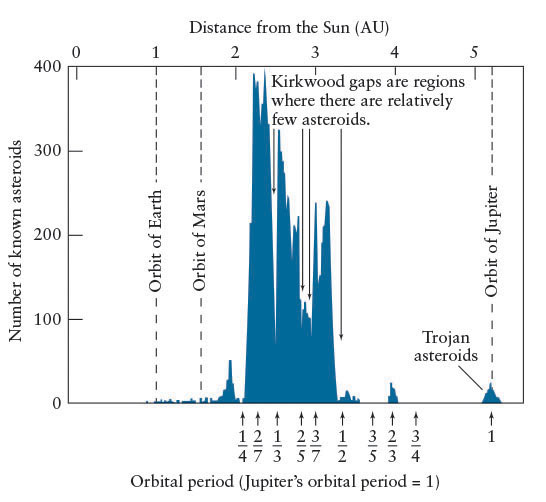
 It is likely that the asteroid belt contains tens of millions of asteroids, yet the typical separation between “neighboring” asteroids is an impressive 1 million km (600,000 mi). This is quite unlike the image that has been created by innumerable popular movies and television shows of asteroids so close together that you must dodge them as you fly past.
It is likely that the asteroid belt contains tens of millions of asteroids, yet the typical separation between “neighboring” asteroids is an impressive 1 million km (600,000 mi). This is quite unlike the image that has been created by innumerable popular movies and television shows of asteroids so close together that you must dodge them as you fly past.
Backstories
Scientists continually apply the “laws of nature” to new situations, problems, observations, experiments, and even popular culture. For example, applying Newton’s law of gravity to the asteroids reveals that they could never swarm, as science fiction movies suggest. At those close quarters, their gravity would cause them either to collide or to pass so close together that they would subsequently fly rapidly and permanently apart.
Despite the large average separation between asteroids, the gravitational influences of Mars and Jupiter have sent some asteroids smashing into each other at various times over the past 4.6 billion years. In 2010, astronomers observed two such events (Figure 9-12). Typical collision velocities are estimated to be 3600 to 18,000 km/h (2000 to 11,000 mi/h), which is more than sufficient to shatter rock. In some collisions, the resulting fragments may not have enough speed to escape from one another’s gravitational attraction, and they reassemble. The asteroid Toutatis (Figure 9-13) appears to be composed of two similarly sized pieces connected to each other, as do the asteroids Castalia and Itokawa (see Figure 9-17). These bodies are therefore likely to have been broken apart and reformed.
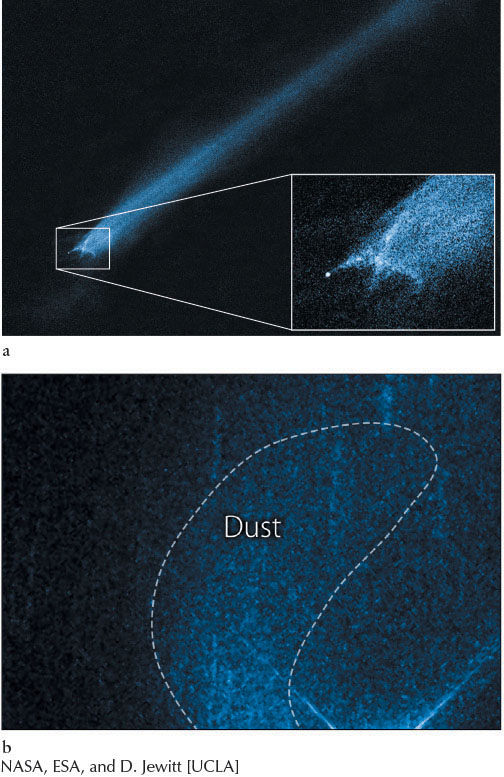
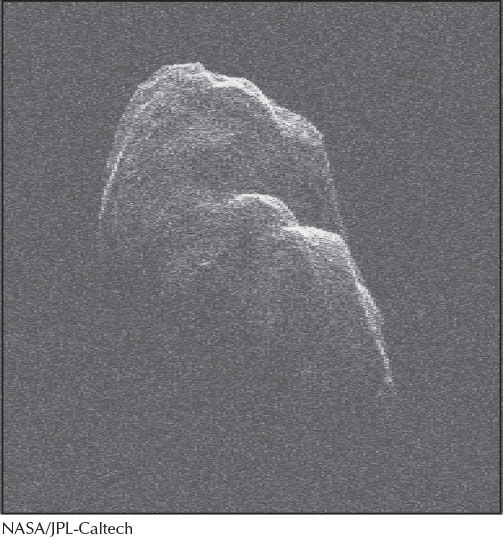
284
Alternatively, several large fragments, such as Ida and Dactyl (Figure 9-14), may end up orbiting each other. Dactyl is a pockmarked asteroid some 1.5 km in diameter that orbits Ida at a distance of 100 km. Petit-Prince is the satellite of Eugenia. Petit-Prince is 13 km across, orbiting 1200 km from the larger body. Asteroid 87 Sylvia has two known satellites, named Romulus and Remus. To date, 234 asteroid-satellite systems have been observed, including several with two moons.
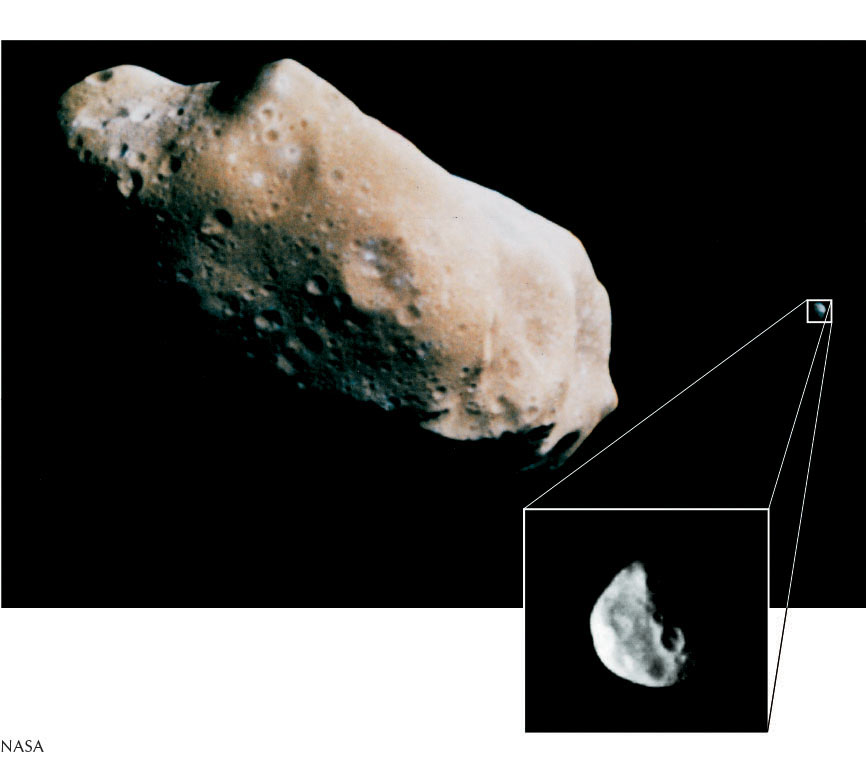
In 1918, the Japanese astronomer Kiyotsugu Hirayama (1874–1943) drew attention to groups of asteroids that share nearly identical orbits. These fragments are pieces of parent asteroids. Pursuing this line of research, astronomers in 2002 discovered that two large asteroids collided only a few million years ago (very recently in solar system history) and created about 20 separate families or clusters of smaller asteroids. Asteroids in each of these families orbit together. The largest remnant cluster of this impact is named Karin, after its largest member, an asteroid some 20 km (12 mi) across.
 In the early 1990s, the Jupiter-bound Galileo spacecraft passed near two asteroids—Gaspra (see Figure 5-7) and Ida (Figure 9-14)—and sent back close-up views. We deduce that Ida is much older because its surface is more heavily cratered than that of Gaspra.
In the early 1990s, the Jupiter-bound Galileo spacecraft passed near two asteroids—Gaspra (see Figure 5-7) and Ida (Figure 9-14)—and sent back close-up views. We deduce that Ida is much older because its surface is more heavily cratered than that of Gaspra.
285
The Sun is not the only star with an asteroid belt. In 2001, astronomers discovered that the star Zeta Leporis (see the star chart on the right), 70 ly from Earth in the constellation Lepus (the Hare), has a disk of debris that appears to contain asteroids. This star system is less than 0.5 billion years old; astronomers hope it will provide insights into the early evolution of the asteroids and other objects in the disk of gas and dust that surrounded the early Sun.
9-5 Asteroids also orbit outside the asteroid belt
While Jupiter’s gravitational pull clears out certain areas within the asteroid belt, it actually captures asteroids at two locations in the path of its own orbit. The gravitational forces of the Sun and Jupiter work together to hold asteroids in orbit at these locations, called stable Lagrange points, in honor of the French mathematician Joseph Lagrange (1736–1813), whose calculations explained them. One Lagrange point is located 60° ahead of Jupiter, and the other is 60° behind, as shown in Figure 9-15 (see also Figure 9-8b).
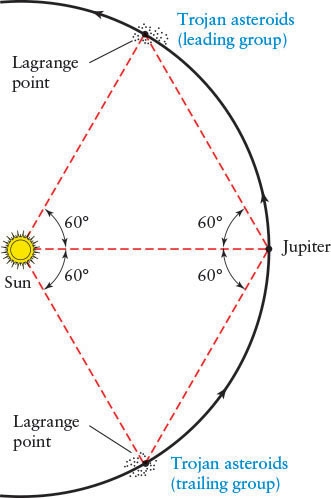
The asteroids trapped at Lagrange points are called Trojan asteroids. Jupiter’s Trojan asteroids are each named after a hero of the Trojan War. As of April 2013, 5846 Trojan asteroids orbiting with Jupiter have been cataloged. Neptune has nine known Trojan asteroids, Mars has five, and Earth and Uranus each have one.
Other asteroids have highly elliptical orbits. Some of these pass through the inner regions of the solar system (see the red dots in Figure 9-8b). The Amor asteroids cross Mars’s orbit, but do not get as close to the Sun as Earth’s orbit, whereas the Apollo asteroids do cross Earth’s orbit. At least 4809 Earth-crossing asteroids are known, several of which are pairs of asteroids that orbit each other. Not all of these Earth-crossing asteroids pose threats to Earth, but at least 1379 of these are potentially hazardous asteroids that may someday strike Earth. Still other asteroids have similarly elliptical orbits that extend from the asteroid belt out beyond the farthest reaches of Pluto’s orbit.
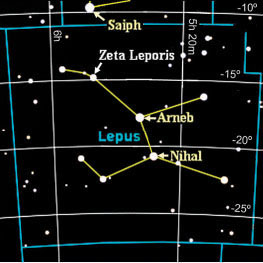
Several close calls took place in recent years. In 1972, space debris was observed to skip off Earth’s atmosphere and retreat back into space. On December 9, 1994, asteroid 1994 XM1 (10 m across—the size of a small bus) passed within 105,000 km (65,000 mi) of Earth. In 2004, asteroid 2004 FU162 (6 m in diameter) passed only 6500 km above Earth’s surface. While not as close as this last one, the most spectacular close approach in recent years occurred in 2013, when asteroid 2012 DA14, half the size of a football field, passed 27,700 km (17,200 mi) from Earth (Figure 9-16). What made this especially dramatic was that a large, unrelated piece of space debris that entered the atmosphere on the same day exploded near the Russian town of Chelyabinsk. We discuss that event in more detail shortly. Near misses within the range of these two events happen virtually every year.
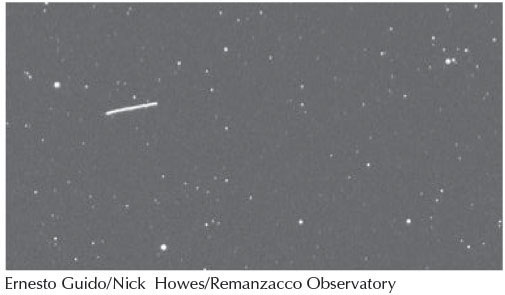
During these close encounters, astronomers can examine the details of asteroids. For example, an asteroid’s brightness often varies as it rotates because different surface features scatter different amounts of light. Such data show that typical rotation periods for asteroids are between 5 and 20 hours, although one asteroid, labeled 2010 JL88, rotates about once every 24.5 seconds! This body is the fastest rotating natural object known in the solar system.
286
The proximity of asteroids and the promise of learning more about these ancient and extremely varied members of our solar system prompted NASA to send the Near Earth Asteroid Rendezvous (NEAR) Shoemaker spacecraft to visit asteroids Mathilde (Figure 9-17a) and Eros. JAXA, the Japanese space agency, sent the Hayabusa spacecraft to the asteroid Itokawa (Figure 9-17b), where the spacecraft attempted to take samples. These maneuvers were only partially successful. The Hayabusa returned to Earth in June 2010 with its cargo. Dust particles were discovered in the spacecraft. In November 2010, some of the dust particles it carried were confirmed to have come from asteroid Itokawa.
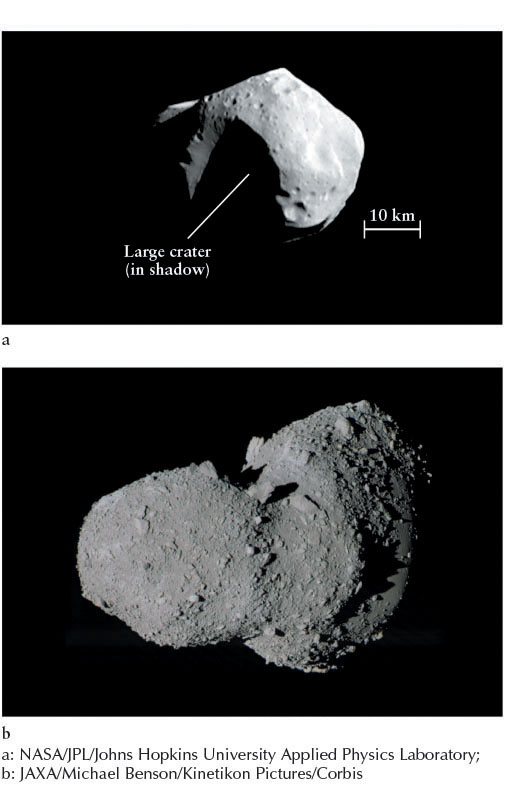
NEAR Shoemaker revealed that Mathilde is only 1.3 times denser than water and has an albedo of 0.04, making it darker than charcoal. This heavily cratered, carbon-rich body therefore has only half the density of the other asteroids astronomers have studied, such as Ida. Eros is about 3 times as dense as water and rotates once every 5¼ hours. In February 2000, NEAR Shoemaker went into orbit around Eros, and for a year the spacecraft’s cameras and other sensors sent back a wealth of information about it.
NEAR Shoemaker also showed that Eros (Figure 9-18) is a chunk of rock and metal. Whether this asteroid is solid or a collection of loosely held pieces is still under investigation. Analyzing Eros’s spectra reveals that it is probably much the same as it was when it coalesced 4.6 billion years ago. Thus, it was never hot enough to differentiate (separate rock from metal). Infrared observations reveal that like our Moon, Eros has regolith. It also has several substantial craters and is strewn with boulders (Figure 9-18c). Astronomers infer from the lack of high crater walls that recent impacts have caused the asteroid to vibrate, collapsing earlier craters. On February 12, 2001, NASA engineers set NEAR Shoemaker onto Eros so gently that the spacecraft was able to transmit data after landing. Details of Eros as small as 1.4 m across were imaged by the spacecraft.

The Asteroids Were a Destroyed Planet?
If the asteroids had been a planet with the mass of Mercury (the smallest known planet), we calculate that there would be 350 times as much debris in the asteroid belt as is known to exist there today. In that case, the rate at which asteroids would leave the asteroid belt due to collisions and near misses with other asteroids would be much greater. Higher rates of rocky debris streaming Earthward over billions of years would have almost certainly led to more mass extinctions and other nightmares for life on Earth.